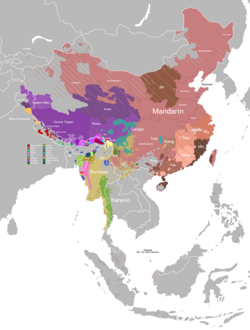You can help expand this article with text translated from the corresponding article in Chinese. (February 2016)Click [show] for important translation instructions.
|
| Taiwanese Hakka | |
|---|---|
| toiˇ vanˇ hagˋ gaˊ ngiˊ / toiˇ vanˇ hagˋ fa Thòi-vàn Hak-kâ-ngî / Thòi-vàn Hak-fa | |
| Pronunciation | Sixian: [tʰoi˩van˩hak̚˨fa˥] Hailu: [tʰoi˥van˥hak̚˨fa˩] Dapu: [tʰoi˧van˩˩˧kʰak̚˨˩fa˥˧] Raoping: [tʰoi˧van˥kʰak̚˥fa˨˦] Zhao'an: [tʰai˧ban˥˧kʰa˥su˥] |
| Native to | Taiwan |
| Region | Taoyuan, Miaoli, Hsinchu, Pingtung, Kaohsiung, Taichung, Nantou, Changhua, Yunlin, Yilan, Hualien and Taitung |
| Ethnicity | Hakka Taiwanese |
| Speakers | L1: 330,000 (2020) [1] L2: 870,000 (2020) [2] Total: 1.2 million (2020) [3] |
| Dialects | |
| Latin (Pha̍k-fa-sṳ) | |
| Official status | |
Official language in | Taiwan [a] |
| Regulated by | Hakka Affairs Council |
| Language codes | |
| ISO 639-3 | – |
| ISO 639-6 | htia |
| Glottolog | None |
| Linguasphere | 79-AAA-gap |
 Proportion of residents aged 6 or older using Hakka at home in Taiwan, in 2010 | |
Taiwanese Hakka is a language group consisting of Hakka dialects spoken in Taiwan, and mainly used by people of Hakka ancestry. Taiwanese Hakka is divided into five main dialects: Sixian, Hailu, Dabu, Raoping, and Zhao'an. [7] The most widely spoken of the five Hakka dialects in Taiwan are Sixian and Hailu. [8] The former, possessing 6 tones, originates from Meizhou, Guangdong, and is mainly spoken in Miaoli, Pingtung and Kaohsiung, while the latter, possessing 7 tones, originates from Haifeng and Lufeng, Guangdong, and is concentrated around Hsinchu. [7] [8] Taiwanese Hakka is also officially listed as one of the national languages of Taiwan. In addition to the five main dialects, there are the northern Xihai dialect and the patchily-distributed Yongding, Fengshun, Wuping, Wuhua, and Jiexi dialects.


